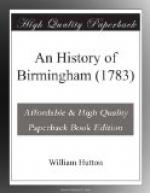For want of a convenient place where the sellers may be collected into one point, they are scattered into various parts of the town. Corn is sold by sample, in the Bull-ring; the eatable productions of the garden, in the same place: butchers stalls occupy Spiceal-street; one would think a narrow street was preferred, that no customer should be suffered to pass by. Flowers, shrubs, etc. at the ends of Philip-street and Moor-street: beds of earthen-ware lie in the middle of the foot ways; and a double range of insignificant stalls, in the front of the shambles, choak up the passage: the beast market is kept in Dale-end: that for pigs, sheep and horses in New-street: cheese issues from one of our principal inns: fruit, fowls and butter are sold at the Old Cross: nay, it is difficult to mention a place where they are not. We may observe, if a man hath an article to sell which another wants to buy, they will quickly find each other out.
Though the market-inconveniencies are great, a man seldom brings a commodity for the support of life, or of luxury, and returns without a customer. Yet even this crowded state of the market, dangerous to the feeble, hath its advantages: much business is transacted in a little time; the first customer is obliged to use dispatch, before he is justled out by a second: to stand all the day idle in the market place, is not known among us.
The upper room of this cross is appropriated for a military guard-house. We find, December 16, 1723, an order made at a public meeting, that “A guard house should be erected in a convenient part of the town, because neither of the crosses were eligible.” But this old order, like some of the new, was never carried into execution. As no complaint lies against the cross, in our time, we may suppose it suitable for the purpose; and I know none but its prisoners that pronounce against it.
SAINT MARTIN’s.
It has been remarked, that the antiquity of this church is too remote for historical light.
The curious records of those dark ages, not being multiplied, and preserved by the art of printing, have fallen a prey to time, and the revolution of things.
[Illustration]
There is reason for fixing the foundation in the eighth century, perhaps rather sooner, and it then was at a small distance from the buildings. The town stood upon the hill, whose centre was the Old Cross; consequently, the ring of houses that now surrounds the church, from the bottom of Edgbaston-street, part of Spiceal-street, the Bull-ring, Corn-cheaping, and St. Martin’s-lane, could not exist.
I am inclined to think that the precincts of St. Martin’s have undergone a mutilation, and that the place which has obtained the modern name of Bull-ring, and which is used as a market for corn and herbs, was once an appropriation of the church, though not used for internment; because the church is evidently calculated for a town of some size, to which the present church-yard no way agrees, being so extremely small that the ancient dead must have been continually disturbed, to make way for the modern, that little spot being their only receptacle for 900 years.




